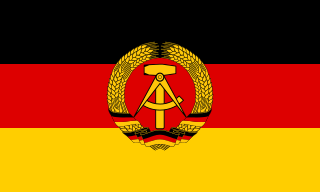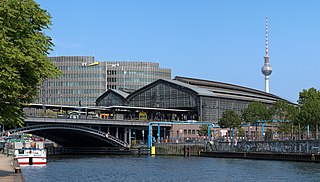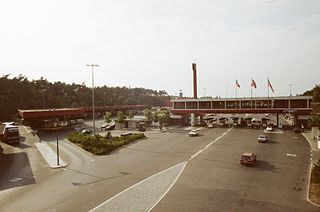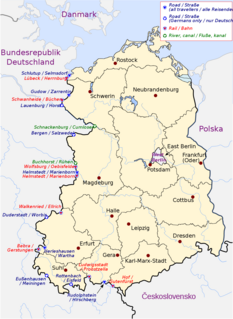Inter-zonal traffic was the cross-border traffic between the four designated garrison zones in Germany between 1945 and 1973 that were created in 1945 by the victors of the Second World War.
Inter-zonal traffic was the cross-border traffic between the four designated garrison zones in Germany between 1945 and 1973 that were created in 1945 by the victors of the Second World War.
Following the military occupation of Germany in May 1945, civilians were initially only allowed to leave their place of residence or its immediate vicinity with a permit from the garrison authority of their zone. By June 1945, the bus and train service within the respective garrison zones had been resumed on many stretches. However, the public train service did not run between the garrison zones. Nevertheless, there were numerous travelers who crossed the extensive uncontrolled boundaries between the garrison zones on foot, by bicycle or by hitch-hiking.
On June 30, 1946, the boundary between the Soviet garrison zone and the Western garrison zones (the American, British and French zones) was blocked. The Soviet military administration in Germany (SMAD) had previously asked the Allies to secure the line of demarcation to the Western zones. A special identification card, the Inter-zones Travel Passport (Germany), known as the inter-zones passport, was introduced by the Allies. This had to be applied for by citizens wishing to travel in occupied Germany.
The passport was valid for 30 days and only valid for travel between zones within Germany. On July 23, 1946, all restrictions on travel between the British and the American garrison zone were canceled (in preparation for the Bizone). In August 1948 the French zone joined the Bizone to become the Trizone. On July 13, 1948, the Soviet Military Administration in Germany (SMAD) issued a decree that travelers between the Western garrison zones and the Soviet garrison zone would also need a residence permit of the Soviet garrison zone in addition to the inter-zones passport.
As of November 14, 1953, the Federal Republic of Germany agreed with the Western Allies to abandon boundary inspection controls for inter-zone traffic. On November 25, 1953, the inter-zones passport was abolished because the GDR government also stopped checking it. GDR inhabitants now had to apply for a departure permit if they wished to leave the zone's boundary. About 4% of GDR citizens traveled into the West with permission but did not return again.
Once the Berlin Wall was built, it became yet substantially more difficult to obtain a departure permit. Except for business trips, only pensioners with family matters to attend to were able to travel into the West and only for a limited amount of time.
On August 5, 1945, the first goods train went out of the Ruhr Valley to Berlin. The non-stop passenger service, however, did not run until May 1946. The first (and until 1949 only) inter-zones express train, which was reserved exclusively for foreign travelers, ran between Berlin and Osnabrück.
The railroad traffic between Berlin and the Western zones was interrupted between April 22, 1948, and May 12, 1949, allegedly due to structural work, but in fact because of the Berlin Blockade crisis. Because the single express train route in inter-zonal traffic (FD 111/112) between Cologne and Berlin was permanently overburdened, five additional express train routes started to run over the German domestic boundary on September 10, 1949:
On August 25, 1946, an inter-zones bus connection was opened between Berlin and Hanover. However the bus traffic was interrupted again and again through political crises. For example, the Erfurt transport company had to stop interzone bus transport, which was also used to obtain spare parts, in 1953.
There was no regular air traffic between the Western zones and the Soviet garrison zone. The first domestic air route was only set up by Lufthansa on August 10, 1989, between Frankfurt am Main and Leipzig. However, several foreign airlines (notably Pan Am and Air Berlin) were permitted to provide service (called Inter-German Service) between West Berlin and several West German cities.

The Berlin Wall was a guarded concrete barrier that physically and ideologically divided Berlin from 1961 to 1989 as well as encircling and separating West Berlin from East German territory. Construction of the wall was commenced by the German Democratic Republic on 13 August 1961. The Wall cut off West Berlin from surrounding East Germany, including East Berlin. The barrier included guard towers placed along large concrete walls, accompanied by a wide area that contained anti-vehicle trenches, beds of nails and other defenses. The Eastern Bloc portrayed the Wall as protecting its population from fascist elements conspiring to prevent the "will of the people" from building a socialist state in East Germany.

West Berlin was a political enclave which comprised the western part of Berlin during the years of the Cold War. Although the legal status as a part of the Federal Republic of Germany was heavily disputed, West Berlin aligned itself politically in 1949 and after with it and was directly or indirectly represented in its federal institutions.
The Soviet Military Administration in Germany was the Soviet military government, headquartered in Berlin-Karlshorst, that directly ruled the Soviet occupation zone of Germany from the German surrender in May 1945 until after the establishment of the German Democratic Republic (GDR) in October 1949.

The Bizone or Bizonia was the combination of the American and the British occupation zones on 1 January 1947 during the occupation of Germany after World War II. With the addition of the French occupation zone on 1 August 1948 the entity became the Trizone. Later, on 23 May 1949, the Trizone became the Federal Republic of Germany, commonly known as West Germany.

The Soviet Occupation Zone was an area of Germany occupied by the Soviet Union as a communist area, established as a result of the Potsdam Agreement on 1 August 1945. On 7 October 1949 the German Democratic Republic (GDR), commonly referred to in English as East Germany, was established in the Soviet Occupation Zone.

The Inner German border was the border between the German Democratic Republic and the Federal Republic of Germany from 1949 to 1990. Not including the similar and physically separate Berlin Wall, the border was 1,393 kilometres long and ran from the Baltic Sea to Czechoslovakia.

Following the collapse and defeat of Nazi Germany in World War II, the victorious Allies asserted joint authority and sovereignty over Germany as a whole, collectively known as Allied-occupied Germany, defined as all territories of the former German Reich west of the Oder–Neisse line, having declared the destruction of Nazi Germany at the death of Adolf Hitler. The four powers divided "Germany as a whole" into four occupation zones for administrative purposes under the three Western Allies and the Soviet Union, respectively. This division was ratified at the August 1945 Potsdam Conference. The four zones were agreed by the United States, United Kingdom and Soviet Union at the February 1945 Yalta Conference, setting aside an earlier division into three zones proposed by the September 1944 London Protocol.

The Deutsche Reichsbahn or DR(German Reich Railways) was the operating name of state owned railways in the German Democratic Republic, and after German reunification until 1 January 1994.

The Berlin border crossings were border crossings created as a result of the post-World War II division of Germany. Prior to the construction of the Berlin Wall in 1961, travel between the Eastern and Western sectors of Berlin was completely uncontrolled, although restrictions were increasingly introduced by the Soviet and East German authorities at major crossings between the sectors. This free access, especially after the closure of the Inner German border, allowed the Eastern Bloc emigration and defection to occur. East German officials, humiliated by this mass defection, subsequently chose to erect the Berlin Wall in order to prevent residents from leaving East Germany.

The German Democratic Republic (GDR), German: Deutsche Demokratische Republik (DDR), often known in English as East Germany, existed from 1949 to 1990. It covered the area of the present-day German states of Mecklenburg-Vorpommern, Brandenburg, Berlin, Sachsen, Sachsen-Anhalt, and Thüringen. This area was occupied by the Soviet Union at the end of World War II excluding the former eastern lands annexed by Poland and the Soviet Union, with the remaining German territory to the west occupied by the British, American, and French armies. Following the economic and political unification of the three western occupation zones under a single administration and the establishment of the Federal Republic of Germany in May 1949, the German Democratic Republic was founded on 7 October 1949 as a sovereign nation.
The Border checkpoint Helmstedt–Marienborn, named Grenzübergangsstelle Marienborn (GÜSt) by the German Democratic Republic (GDR), was the largest and most important border crossing on the Inner German border during the division of Germany. Due to its geographical location, allowing for the shortest land route between West Germany and West Berlin, most transit traffic to and from West Berlin used the Helmstedt-Marienborn crossing. Most travel routes from West Germany to East Germany and Poland also used this crossing. The border crossing existed from 1945 to 1990 and was situated near the East German village of Marienborn at the edge of the Lappwald. The crossing interrupted the Bundesautobahn 2 (A 2) between the junctions Helmstedt-Ost and Ostingersleben.

The Berlin Stadtbahn is a major railway thoroughfare in the German capital Berlin, which runs through Berlin from east to west. It connects the eastern district of Friedrichshain with Charlottenburg in the west via 11 intermediate stations including Hauptbahnhof. The Berlin Stadtbahn is often also defined as the slightly longer route between Ostkreuz and Westkreuz, although this is not technically correct.

Berlin Friedrichstraße is a railway station in the German capital Berlin. It is located on the Friedrichstraße, a major north-south street in the Mitte district of Berlin, adjacent to the point where the street crosses the river Spree. Underneath the station is the U-Bahn station Friedrichstraße.

Berlin has developed a highly complex transportation infrastructure providing very diverse modes of urban mobility. 979 bridges cross 197 kilometers of innercity waterways, 5,334 kilometres (3,314 mi) of roads run through Berlin, of which 73 kilometres (45 mi) are motorways. Long-distance rail lines connect Berlin with all of the major cities of Germany and with many cities in neighboring European countries. Regional rail lines provide access to the surrounding regions of Brandenburg and to the Baltic Sea.

Checkpoint Bravo was the name given by the Western Allies to the main Autobahn border crossing point between West Berlin and the German Democratic Republic. It was known in German as Grenzübergangsstelle Drewitz-Dreilinden. Drewitz is a community nearby, and Dreilinden is the name of the wooded area in Berlin through which the highway passes.
The development of the inner German border took place in a number of stages between 1945 and the mid-1980s. After its establishment in 1945 as the dividing line between the Western and Soviet occupation zones of Germany, in 1949 the inner German border became the frontier between the Federal Republic of Germany and the German Democratic Republic. The border remained relatively easy to cross until it was abruptly closed by the GDR in 1952 in response to the large-scale emigration of East Germans to the West. Barbed-wire fences and minefields were installed and draconian restrictions were placed on East German citizens living near the border. Thousands were expelled from their homes, with several thousand more fleeing to the West. From the late 1960s, the border fortifications were greatly strengthened through the installation of new fences, detectors, watchtowers and booby-traps designed to prevent attempts to escape from East Germany. The improved border defences succeeded in reducing the scale of unauthorised emigration to a trickle.

Crossing the inner German border remained possible throughout the Cold War; it was never entirely sealed in the fashion of the border between the two Koreas, though there were severe restrictions on the movement of East German citizens. The post-war agreements on the governance of Berlin specified that the Western Allies were to have access to the city via defined air, road, rail and river links. This was mostly respected by the Soviets and East Germans, albeit with periodic interruptions and harassment of travellers. Even during the Berlin Blockade of 1948, supplies could be brought in by air – the famous Berlin Airlift – and Allied military convoys could pass through East Germany en route to Berlin.

The Neudietendorf–Ritschenhausen railway connects Neudietendorf and Ritschenhausen in the German state of Thuringia. It is a mainly single-track main line operated by DB Netze.

The Lübeck–Bad Kleinen railway is a single-track, non-electrified main line between the German states of Schleswig-Holstein and Mecklenburg-Vorpommern. Its construction was started by the Lübeck-Kleinen Railway Company and, after that company's bankruptcy, it was completed and opened by the Friedrich-Franz Railway (Friedrich-Franz-Eisenbahn).

The State of Brandenburg was a subdivision of the Soviet occupation zone and state of East Germany which corresponds widely to the present-day German state Brandenburg. The state was originally formed as administrative division Province of March Brandenburg by the Soviet Military Administration in Germany (SMAD) in July 1945, a re-establishment of the Prussian Province of Brandenburg, excluding the Eastern parts behind the Oder–Neisse line to Poland. With the abolition of Prussia in February 1947, it was named State of March Brandenburg but in June 1947 the SMAD forced to change the name to State of Brandenburg. In August 1945, a transfer of territory was ruled out between Allied-occupied Berlin. Compared to the administrative divisions of Nazi Germany, it comprised the Western part of the Gau March Brandenburg and small parts of Berlin.